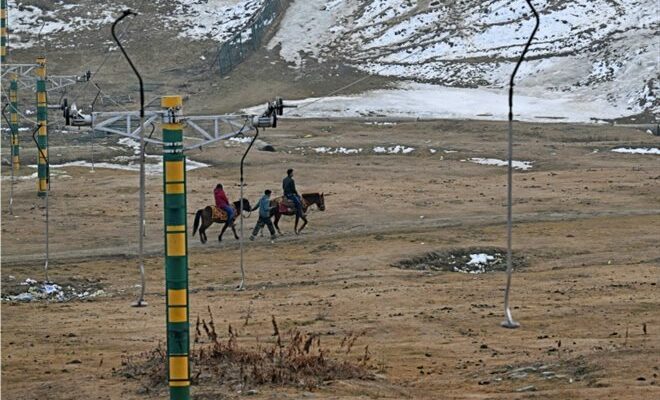Absence of snow on the slopes of the Gulmarg station, in the Indian Himalayas, January 17, 2024 (AFP/TAUSEEF MUSTAFA)
In the Himalayas, winter should bring a thick blanket of snow, but Gulmarg, one of the world’s highest ski resorts in Indian Kashmir, is desperate for the thousands of tourists it attracts usually.
This year, the powder that usually covers the region is absent. The mountain slopes remained brown and bare, exceptional weather conditions linked, according to experts, to global warming.
The lack of snow not only hits the ski sector, but also worries agriculture, the pillar of Kashmir’s economy.
“Seeing Gulmarg without snow makes me want to cry every day,” laments Mubashir Khan, adventure travel organizer. He had to put his wedding plans on hold because his business was on the verge of bankruptcy.
“In the 20 years that I have been working here, this is the first time that I have not seen snow in Gulmarg in January,” explains Majeed Bakshi, whose heli-skiing service aimed at the wealthiest tourists is at a standstill. A single helicopter awaits the few tourists still present, offering to fly over higher peaks covered in snow.
“Our customers are mainly skiers and they have all canceled their reservations,” says Hamid Masoodi, a hotel manager. “Those who come despite the lack of snow are disappointed.”
The ski lifts are closed, so are the rental shops and a new ice rink looks like a swimming pool.
“The current dry spell is an extreme weather event,” one of those phenomena that “is expected to become more intense and more frequent in the future,” says climatologist Shakil Romshoo of the Islamic University of Science and Technology in Kashmir.
– Rising temperatures –
For decades, this region saw a separatist insurgency suppressed by military operations, which left tens of thousands of civilians, soldiers and rebels dead.

Tourists walk on the private snow slopes of the Gulmarg ski resort, about fifty kilometers from Srinagar, in the Indian Himalayas, January 17, 2024 (AFP/TAUSEEF MUSTAFA)
When the insurgency subsided, India heavily encouraged tourism to these spectacular mountain landscapes.
But in Gulmarg, hotel reservations have fallen by three-quarters, tourism professionals say, and hundreds of idle guides and snowmobile drivers wait in the sun.
“Most foreigners, who come mainly to ski (…) have canceled,” laments Majeed Bakshi. “I lost about 70% of bookings.”
At an altitude of 2,650 meters, the station also houses a war school specializing in conflicts at altitude (Haws). It is located near the militarized “line of control”, the de facto border between India and Pakistan who dispute sovereignty over Kashmir.
The region has seen little rain this year and temperatures have averaged six degrees Celsius warmer than normal since last fall, according to the weather service.
Last month, rainfall in Kashmir was 80% lower than in previous years. The few snow showers that fell on Gulmarg quickly melted.
India’s Ministry of Earth Sciences expects a particularly strong impact from global warming in the Himalayas and Kashmir, according to a 2020 report.
In early January, the UN World Meteorological Organization announced that 2023 had been “by far” the hottest year on record. The annual average global temperature in 2023 was 1.45 degrees Celsius above pre-industrial levels (1850-1900).
– Prolonged droughts –
In Kashmir, the impact is clearly visible. The bowl-shaped landscape of Gulmarg, popular with tourists for its snow in winter and flowery meadows in spring, is brown and gloomy.

A guide leads a horseback ride on the slopes of Gulmarg resort, India, January 17, 2024 (AFP/TAUSEEF MUSTAFA)
In addition to a collapse in the ski industry, area residents worry about a water shortage that could have a disastrous impact on agriculture.
According to climatologist Shakil Romshoo, Kashmir is “expected to experience more frequent and prolonged periods of drought” in the coming decades.
Climate change has already pushed farmers to change their practices. This week, authorities in Kashmir warned of water shortages and the risk of forest fires due to a lack of snow, which usually feeds rivers.
Farmers have abandoned rice for fruit trees, which use less water. But with the drought and sunshine, trees are already in flower, more than two months in advance.
© 2024 AFP
Did you like this article ? Share it with your friends using the buttons below.




